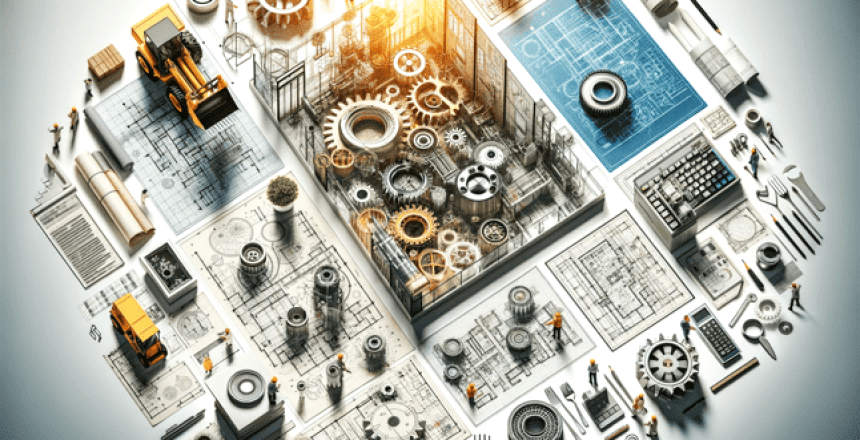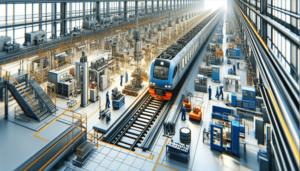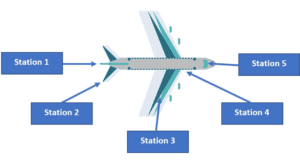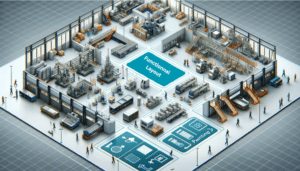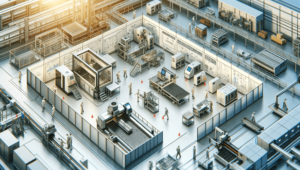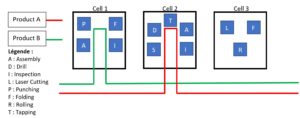In the intricate dance of manufacturing and business operations, one element stands out as the choreographer: the business or plant layout. This arrangement is more than just a blueprint; it is the heartbeat that dictates the flow of products, the efficiency of workers, and the speed of delivery.
It plays a pivotal role in the overall system performance. By streamlining processes and reducing redundancies, an effective layout empowers a company to diminish or even eliminate non-value-added operations, such as unnecessary movements, leading to not only increased efficiency but also enhanced profitability.
In this article, we delve into the intricacies of different layouts, their strengths, weaknesses, and their impact on various production systems.
Understanding Business Layout
The design of a business plays an instrumental role in determining its productivity and profitability. Yet, its significance is often overlooked, which can lead to vulnerabilities in many Small and Medium Enterprises (SMEs). The effects of a well-structured versus a poorly constructed layout can be best illustrated through practical examples or case studies.
The business or factory layout dictates the arrangement of various components within a company. It aims to strategically position machinery, equipment, and tools to maximize value-added operations. Implementing specific strategies or techniques can further optimize this arrangement.
Variations in Business Layout
Different production methodologies necessitate varied layouts. Each layout comes with its own set of advantages and drawbacks, and certain designs resonate better with specific production methods, products, or volume levels. The elucidation of these layouts is made clearer with illustrative examples.
Primarily, there are three conventional production systems: the shop production system (job shop), batch production, and mass production. To encapsulate the traits of these three manufacturing systems, here is a table from Sassani (2016).
| Characteristic | Production System | ||
| Job-shop | Batch | Mass | |
| Quantity to produce | Weak | High | Very High |
| Production rate | Weak | High | Very High |
| Skill required (Labour) | Very High | High | Weak |
| Equipment | General | General | Special |
| Tools | General | Special | Special |
| Degree of automation | Weak | High | Very High |
The chosen production system heavily influences the selection of a layout. Predominant layouts include fixed, functional (process), cellular, and production line layouts. To provide a comprehensive understanding, let’s delve into real-world applications where these layouts are predominantly employed.
Fixed business (factory) layout
A fixed layout in manufacturing is tailored for large, heavy, or complex products that are difficult to move, such as ships, trains, large machinery, or airplanes.
In this layout, the product remains stationary, and workers, tools, and materials move around it. This setup minimizes the need for moving the product, which can be costly and time-consuming.
Fixed layouts are ideal for custom or large-scale products that require extensive assembly or construction. They allow for a high degree of customization and flexibility in the production process but are less efficient for the mass production of smaller items.
Functional (process) layout
Functional layouts prioritize the clustering of machinery and equipment based on their function. It offers unparalleled flexibility, catering to the production of diverse parts in small batches.
This layout necessitates a skilled workforce that can operate multiple machines and produce varied parts. However, it tends to occupy more space, especially for storing work-in-progress and raw materials.
While it provides flexibility, it may lack agility in certain situations. The volume of production needs to be carefully balanced to ensure profitability.
Cellular Layout
A cellular layout in manufacturing organizes the production floor into distinct cells, each dedicated to a specific set of processes or product family. This layout is designed to minimize unnecessary movement and handling, enhancing efficiency and reducing production time.
Each cell operates as a self-contained unit with all the necessary equipment and resources to complete a product or component. This setup is particularly effective for companies that produce a variety of products requiring different production processes.
Cellular layouts offer the flexibility to adapt to changing production needs, improve quality control, and enhance worker skills through cross-training in various cells.
Production line
A production line layout is characterized by a sequential arrangement of operations, equipment, and workers in a factory, specifically designed for the continuous mass production of goods.
In this setup, the product moves along a conveyor belt or assembly line, passing through different stages of production where specific tasks are performed.
This layout is highly efficient for manufacturing large volumes of uniform products, as it allows for the specialization of labor and machinery.
However, it’s less flexible in accommodating product variety or changes in design. Production lines are commonly used in industries such as automotive, electronics, and food processing, where speed and consistency are key.
Dynamic Cell Layout
A dynamic cell layout is an innovative approach in manufacturing that emphasizes flexibility and adaptability. Unlike traditional layouts, dynamic cells are designed to rapidly reconfigure based on changing production needs. This allows manufacturers to efficiently switch between different products without extensive downtime or retooling.
For instance, a dynamic cell might produce one type of product during a certain season and then switch to another product as demand shifts. This agility is particularly beneficial for companies facing variable product demand or producing a diverse range of items.
By minimizing setup times and maximizing resource utilization, dynamic cell layouts offer a responsive solution to modern manufacturing challenges.
In this example, cell 1 produces snowmobiles in the summer. In winter, the company reconfigures its work cell to manufacture personal watercraft.
Therefore makes it possible to manufacture 2 different products, at the right time, without having to dedicate 2 production lines, duplicate equipment, workspace, etc.
Summary Table
Finally, here is a summary table of all the types of layouts presented in this article. The table is taken from (Sassani, 2016).
| Characteristic | Types of Layout | |||
| Functional | Cellular | Production line | Dynamic Cell | |
| Specialization | By Process | By Family Product | By Product | By Family Product |
|
Material flow |
Batch | Batch, almost continuously | Continuously | Batch, almost continuously |
|
Travel time (material) |
High | Weak | Very Weak | Weak |
| Level of in-progress | High | Weak | Very Weak | Weak |
|
Material flow control |
Complex | Simple | Very Simple | Simple |
|
Job satisfaction |
Moderate-High | High | Weak | High |
| Flexibility | High | Moderate-High | Very Weak | High |
| Agility | Weak | High | Very Weak | Very High |
Reference :
Rheault, M., Drolet, J., & Abdulnour, G. LES CELLULES DYNAMIQUES: UN CONCEPT POUR PME.
Sassani, F. (2016). Industrial engineering foundations: Bridging the gap between engineering and management. Chapter 3: Manufacturing Systems. Stylus Publishing, LLC.

